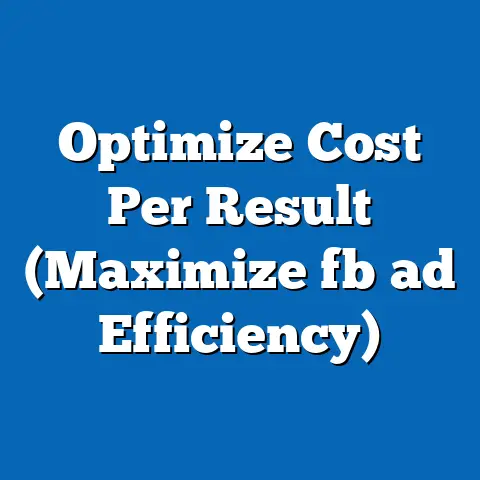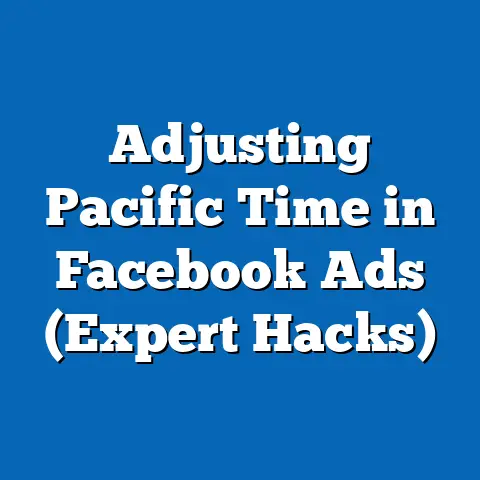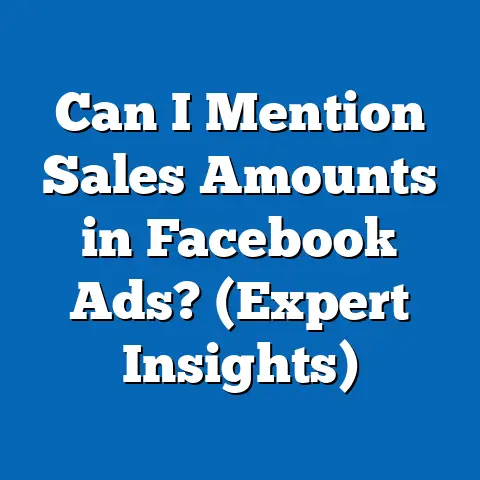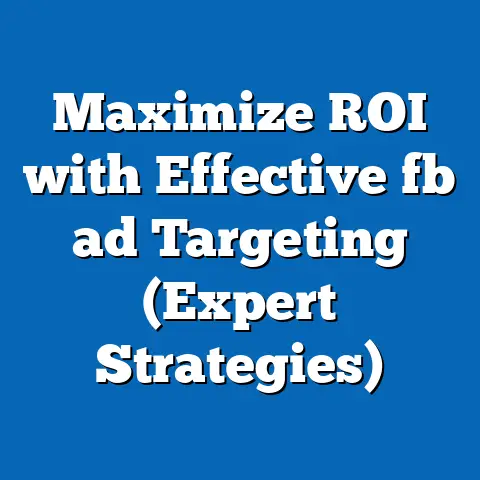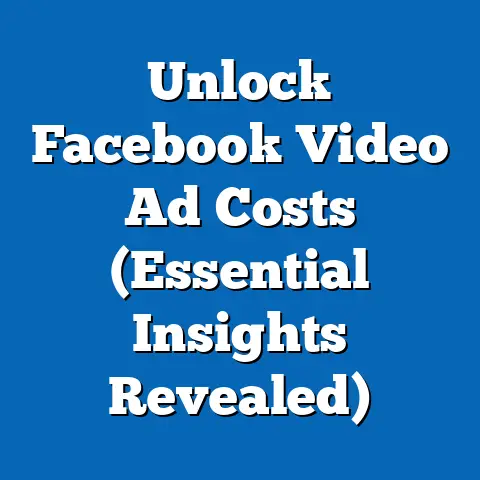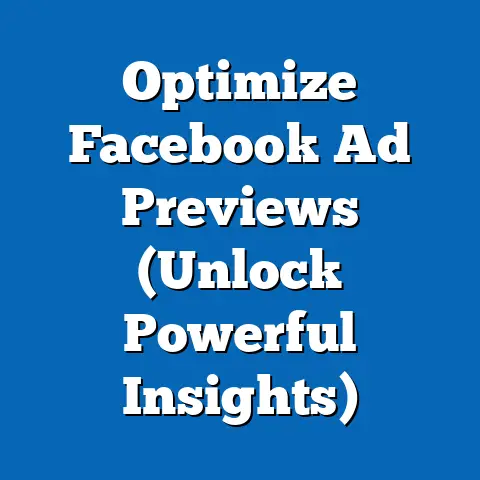Master Facebook Ads for App Installs (Proven Strategies)
Do you remember the thrill of discovering a new app that changed your daily routine? Maybe it was a game that kept you glued to your screen for hours, a productivity tool that revolutionized your workflow, or a social platform that connected you with friends and family in a whole new way. I certainly do! I remember the day I stumbled upon a photo editing app that completely transformed my Instagram game. It was a simple discovery, but it led to a huge boost in my engagement and even opened up new opportunities for collaborations.
In today’s mobile-first world, app installs are the lifeblood of countless businesses. Whether you’re a game developer, a SaaS startup, or a large enterprise, getting your app into the hands of users is crucial for growth and success. And that’s where Facebook Ads comes in. With its massive user base, sophisticated targeting capabilities, and diverse ad formats, Facebook offers a powerful platform to drive app downloads and connect with your ideal audience. I’ve personally seen Facebook Ads transform struggling app launches into roaring successes, and I’m excited to share the strategies that make it happen.
Understanding the Value of Facebook Ads for App Installs
Facebook is more than just a social network; it’s a global advertising powerhouse. With billions of active users, Facebook provides unparalleled reach and targeting capabilities for app marketers. Think about it: where else can you connect with such a diverse and engaged audience, precisely targeted based on their interests, demographics, and behaviors?
The advantages of using Facebook Ads for app installs are numerous:
- Cost-Effectiveness: Facebook allows you to set your own budget and optimize your campaigns for maximum ROI. You can start small and scale up as you see results, making it accessible for businesses of all sizes. I remember helping a small indie game developer launch their first app using a modest Facebook Ads budget. Within weeks, they saw a significant increase in downloads and user engagement, proving that you don’t need a massive budget to make a big impact.
- Targeted Reach: Facebook’s sophisticated targeting options enable you to reach the right users at the right time. You can target users based on demographics, interests, behaviors, and even their mobile device usage. This level of precision ensures that your ads are seen by people who are most likely to download and use your app.
- High Engagement: Facebook Ads are designed to be engaging and interactive. With formats like video ads, carousel ads, and playable ads, you can showcase your app’s features and benefits in a compelling way. I’ve found that video ads, in particular, are incredibly effective for app promotion, as they allow you to demonstrate the app’s functionality and user experience.
According to Statista, mobile app usage continues to grow year after year. In 2023, the average smartphone user spent over 4 hours per day using apps. This highlights the immense opportunity for app developers to reach and engage with their target audience through mobile apps. Harnessing social media platforms like Facebook for app promotion is no longer a luxury, but a necessity.
Key Takeaway: Facebook Ads offer a cost-effective and highly targeted way to reach potential app users. By leveraging its vast user base and diverse ad formats, you can drive app installs and achieve your marketing goals.
Setting Up Your Facebook Ads Campaign for App Installs
Setting up a successful Facebook Ads campaign for app installs requires careful planning and execution. Here’s a step-by-step guide to get you started:
- Campaign Objective: The first step is to select the right campaign objective. In this case, you’ll want to choose “App Installs.” This tells Facebook that you want to optimize your ads for users who are most likely to download your app. I’ve seen many marketers make the mistake of choosing the wrong objective, which can lead to wasted ad spend and poor results.
- Target Audience: Defining your target audience is crucial for success. Consider factors like demographics (age, gender, location), interests (hobbies, passions), and behaviors (mobile device usage, app preferences). Facebook offers powerful targeting options that allow you to narrow down your audience and reach the most relevant users. For example, if you’re promoting a fitness app, you might target users who are interested in health and wellness, exercise, and healthy eating.
-
Ad Format: Choosing the right ad format is essential for capturing attention and driving engagement. Facebook offers a variety of ad formats for app promotion, including:
- Single Image Ads: These are simple and effective for showcasing your app’s logo or a key feature.
- Video Ads: These are great for demonstrating your app’s functionality and user experience. I always recommend creating short, engaging video ads that highlight the app’s key benefits.
- Carousel Ads: These allow you to showcase multiple images or videos in a single ad, making them ideal for highlighting different features or use cases.
- Playable Ads: These are interactive ads that allow users to try out your app before downloading it. This is a great way to drive high-quality installs.
I’ve personally found that carousel ads and video ads tend to perform best for app promotion, as they allow you to tell a more compelling story and showcase your app’s value proposition.
-
Ad Copy and Visuals: Your ad copy and visuals should be compelling and relevant to your target audience. Highlight the key benefits of your app and use clear, concise language. Your visuals should be eye-catching and visually appealing. I always recommend using high-quality images or videos that showcase your app in the best possible light.
- Call to Action: Include a clear call to action that encourages users to download your app. Use phrases like “Install Now,” “Download Now,” or “Get Started.” Make sure your call to action is prominent and easy to click.
Ad Format: Choosing the right ad format is essential for capturing attention and driving engagement. Facebook offers a variety of ad formats for app promotion, including:
- Single Image Ads: These are simple and effective for showcasing your app’s logo or a key feature.
- Video Ads: These are great for demonstrating your app’s functionality and user experience. I always recommend creating short, engaging video ads that highlight the app’s key benefits.
- Carousel Ads: These allow you to showcase multiple images or videos in a single ad, making them ideal for highlighting different features or use cases.
- Playable Ads: These are interactive ads that allow users to try out your app before downloading it. This is a great way to drive high-quality installs.
I’ve personally found that carousel ads and video ads tend to perform best for app promotion, as they allow you to tell a more compelling story and showcase your app’s value proposition.
Ad Copy and Visuals: Your ad copy and visuals should be compelling and relevant to your target audience. Highlight the key benefits of your app and use clear, concise language. Your visuals should be eye-catching and visually appealing. I always recommend using high-quality images or videos that showcase your app in the best possible light.
Key Takeaway: Setting up your Facebook Ads campaign correctly is crucial for success. By selecting the right campaign objective, defining your target audience, choosing the right ad format, and creating compelling ad copy and visuals, you can increase your chances of driving app installs and achieving your marketing goals.
Proven Strategies to Optimize Your Facebook Ads
Once you’ve set up your Facebook Ads campaign, the real work begins. Optimizing your ads for maximum performance requires continuous monitoring, testing, and refinement. Here are some proven strategies to help you optimize your Facebook Ads for app installs:
- A/B Testing: A/B testing involves creating multiple versions of your ads and testing them against each other to see which performs best. You can test different ad copy, visuals, targeting options, and call to actions. I always recommend A/B testing different ad creatives to see which resonates best with your target audience. You might be surprised at what you discover!
- Lookalike Audiences: Facebook’s Lookalike Audiences allow you to reach potential users who are similar to your existing user base. This is a powerful way to expand your reach and target users who are most likely to download your app. I’ve seen Lookalike Audiences significantly improve campaign performance for many of my clients.
- Retargeting: Retargeting involves showing ads to users who have previously interacted with your app or website. This is a great way to re-engage users who have shown interest but have not yet installed the app. You can retarget users who have visited your app store page, watched a video about your app, or added your app to their wishlist. I’ve found that retargeting campaigns are particularly effective for driving conversions.
-
Analyzing Ad Performance Metrics: Regularly analyzing your ad performance metrics is essential for identifying areas for improvement. Key metrics to monitor include:
- Cost Per Install (CPI): This is the average cost you pay for each app install.
- Click-Through Rate (CTR): This is the percentage of users who click on your ad.
- Engagement Rate: This is the percentage of users who interact with your ad (e.g., likes, comments, shares).
- Conversion Rate: This is the percentage of users who download your app after clicking on your ad.
By analyzing these metrics, you can identify which ads are performing well and which are not. You can then make data-driven adjustments to improve your ROI. I always recommend setting up conversion tracking to accurately measure your ad performance.
Analyzing Ad Performance Metrics: Regularly analyzing your ad performance metrics is essential for identifying areas for improvement. Key metrics to monitor include:
- Cost Per Install (CPI): This is the average cost you pay for each app install.
- Click-Through Rate (CTR): This is the percentage of users who click on your ad.
- Engagement Rate: This is the percentage of users who interact with your ad (e.g., likes, comments, shares).
- Conversion Rate: This is the percentage of users who download your app after clicking on your ad.
By analyzing these metrics, you can identify which ads are performing well and which are not. You can then make data-driven adjustments to improve your ROI. I always recommend setting up conversion tracking to accurately measure your ad performance.
I once worked with a client who was struggling to drive app installs despite having a well-designed app and a compelling marketing message. After analyzing their ad performance metrics, I discovered that their CPI was significantly higher than the industry average. By A/B testing different targeting options and ad creatives, I was able to reduce their CPI by 50% and significantly increase their app installs.
Key Takeaway: Optimizing your Facebook Ads requires continuous monitoring, testing, and refinement. By implementing A/B testing, utilizing Lookalike Audiences, implementing retargeting strategies, and analyzing ad performance metrics, you can improve your ROI and drive more app installs.
Leveraging Facebook Analytics for Continuous Improvement
Facebook Analytics is a powerful tool that provides valuable insights into your app’s performance and user behavior. By leveraging Facebook Analytics, you can gain a deeper understanding of your users and make data-driven decisions to improve your app and ad strategies.
Here’s how you can use Facebook Analytics for continuous improvement:
-
Track Key Metrics: Facebook Analytics allows you to track a variety of key metrics, including:
- App Installs: This is the number of users who have installed your app.
- Active Users: This is the number of users who are actively using your app.
- Retention Rate: This is the percentage of users who continue to use your app over time.
- User Demographics: This provides insights into the age, gender, location, and interests of your users.
- User Behavior: This tracks how users are interacting with your app, including which features they are using and how long they are spending in the app.
By tracking these metrics, you can identify areas for improvement and make data-driven decisions to optimize your app and ad strategies. * Interpret Key Metrics: Once you’ve tracked your key metrics, it’s important to interpret them correctly. For example, if you see that your retention rate is low, you might need to improve your app’s onboarding process or add new features to keep users engaged. If you see that certain user demographics are more engaged than others, you might want to adjust your targeting options to focus on those demographics. * User Feedback and Reviews: Pay close attention to user feedback and reviews. This is a valuable source of information about what users like and dislike about your app. Use this feedback to refine your ad strategies and improve your app features. I always encourage my clients to actively engage with users and respond to their feedback. This shows that you care about their experience and are committed to improving your app.
Track Key Metrics: Facebook Analytics allows you to track a variety of key metrics, including:
- App Installs: This is the number of users who have installed your app.
- Active Users: This is the number of users who are actively using your app.
- Retention Rate: This is the percentage of users who continue to use your app over time.
- User Demographics: This provides insights into the age, gender, location, and interests of your users.
- User Behavior: This tracks how users are interacting with your app, including which features they are using and how long they are spending in the app.
By tracking these metrics, you can identify areas for improvement and make data-driven decisions to optimize your app and ad strategies. * Interpret Key Metrics: Once you’ve tracked your key metrics, it’s important to interpret them correctly. For example, if you see that your retention rate is low, you might need to improve your app’s onboarding process or add new features to keep users engaged. If you see that certain user demographics are more engaged than others, you might want to adjust your targeting options to focus on those demographics. * User Feedback and Reviews: Pay close attention to user feedback and reviews. This is a valuable source of information about what users like and dislike about your app. Use this feedback to refine your ad strategies and improve your app features. I always encourage my clients to actively engage with users and respond to their feedback. This shows that you care about their experience and are committed to improving your app.
Key Takeaway: Facebook Analytics provides valuable insights into your app’s performance and user behavior. By tracking key metrics, interpreting them correctly, and paying attention to user feedback and reviews, you can continuously improve your app and ad strategies.
Case Studies and Success Stories
To illustrate the power of Facebook Ads for app installs, let’s take a look at some real-world examples and success stories:
- Game Developer: A small indie game developer used Facebook Ads to launch their first app. By targeting users who were interested in similar games and creating engaging video ads, they were able to drive a significant number of app installs and achieve a high return on investment. They shared with me that Facebook Ads were instrumental in getting their app off the ground and building a loyal user base.
- Fitness App: A fitness app used Facebook Ads to reach users who were interested in health and wellness. By creating targeted ads that highlighted the app’s key features and benefits, they were able to drive a significant increase in app installs and active users. They found that carousel ads, which showcased different workout routines and features, were particularly effective.
- E-commerce App: An e-commerce app used Facebook Ads to retarget users who had previously visited their website but had not yet installed the app. By showing these users targeted ads that featured the products they had viewed, they were able to drive a significant number of app installs and increase their sales. The key was to personalize the ads based on the user’s previous browsing history.
These case studies demonstrate the versatility and effectiveness of Facebook Ads for app promotion. By implementing the strategies I’ve discussed in this guide, you can achieve similar results for your own app.
Key Takeaway: Real-world examples and success stories demonstrate the power of Facebook Ads for app installs. By learning from these examples and implementing the strategies I’ve discussed in this guide, you can achieve similar results for your own app.
Conclusion
Facebook Ads offer a powerful platform for driving app installs and connecting with your ideal audience. By understanding the value of Facebook Ads, setting up your campaigns correctly, optimizing your ads for maximum performance, leveraging Facebook Analytics, and learning from real-world examples, you can unlock the full potential of Facebook advertising for your app.
I hope this guide has provided you with valuable insights and actionable tips to help you master Facebook Ads for app installs. Remember that success with Facebook Ads requires continuous learning, testing, and refinement. Don’t be afraid to experiment with different strategies and see what works best for your app.
Start your Facebook Ads journey today and transform your app’s reach and success!

